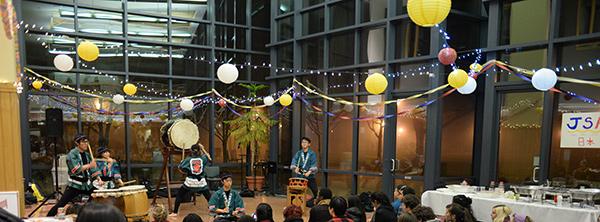The Culture Behind the Food
December 15, 2015
Xiaoqian Zhu

Photo credit: Jeong Hyun Hwang
Is Asian food popular in America? Just look around Oberlin: Even in such a small town, there are three restaurants dedicated to Asian cuisines. However, people are often not exposed to the cultures behind these delicious foods. This year, the students from Asian countries and the Asian diaspora, who were organizing the fifth-annual Asian Night Market, wanted to address this divide. They decided to expand the event beyond serving homemade dishes and traditional performances to also include a discussion about the relationship between food, culture, and people.
Created in 2011, Asian Night Market models itself after the popular night markets in many Asian countries that feature food and entertainment. Made possible by the collaborative efforts of the Asian American Alliance, Chinese Student Association, Oberlin Korean Student Association, South Asian Student Association, Filipino American Student Association, Japanese Student Association, and Vietnamese Student Association, the night market is an opportunity for Asian students to celebrate and show appreciation to their cultures, friendships, and communities.
This year, for the first time the market was preceded by a series of educational events in a ”Food for Thought Week.” The events aimed to raise awareness of the distinctions within Asian cultures and Asian food. Tim Chung, a fourth-year creative writing major and a key proponent of the event, says he thinks Asian food needs to be more than just consumed. “The idea of having a symposium is to get people to think about the people behind the food because it’s deeply ingrained in culture,” Chung says. “People need to know the face behind the food and the relationship between food and power, and they need to think about power dynamics of Asian food in America, particularly because Asian food traditionally has been adapted in America.”
Chung says he envisions a larger symposium in the future, but he thinks educational events and discussions are a great start. Student representatives organized two panels. The first was about the many ways to prepare rice and other foods in different Asian countries, while the second focused on the Americanization of Asian cuisines.
Soomin Kim, a second-year composition major and cochair of Oberlin Korean Student Association, was one of the representatives on the panel about rice. “I mostly talked about how Korean people make rice and different dishes using rice, like ssambap (Korean rice wrap),” she says. “Another thing that is different is the ways that rice is cooked. We use rice to make porridge, especially when you are sick.”
Beatrice Chum, a second-year and cochair of Chinese Student Association, says the preparation for Asian Night Market was intensive, but the results were positive. “There has been a lot of thought and debate about what constitutes Asian Night Market, and I think the discussions that have been raised are very important.”
Food for Thought Week culminated on Saturday in the night market itself. Attendees sampled food from different countries and cultures and enjoyed some traditional musical performances, including a Chinese folk song performed by third-year Hengxuan Wu, a Vietnamese folk song, a Japanese instrumental piece, and a performance by Oberlin College Taiko.
You may also like…
Josh Nolan Named Vice President, General Counsel, and Secretary at Oberlin
Distinguished attorney brings extensive experience in higher education law.
Learning by Teaching: Oberlin Students Share Global Music with Young Learners
College and Conservatory students in PACE 103 prepare local children for an immersive community concert at Oberlin.
Nuiko Wadden ’02 Joins Oberlin Conservatory Faculty as Assistant Professor of Harp
The versatile musician brings extensive opera, orchestral, and contemporary music experience to her role


